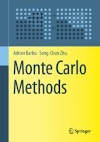- About MAA
- Membership
- MAA Publications
- Periodicals
- Blogs
- MAA Book Series
- MAA Press (an imprint of the AMS)
- MAA Notes
- MAA Reviews
- Mathematical Communication
- Information for Libraries
- Author Resources
- Advertise with MAA
- Meetings
- Competitions
- Programs
- Communities
- MAA Sections
- SIGMAA
- MAA Connect
- Students
- MAA Awards
- Awards Booklets
- Writing Awards
- Teaching Awards
- Service Awards
- Research Awards
- Lecture Awards
- Putnam Competition Individual and Team Winners
- D. E. Shaw Group AMC 8 Awards & Certificates
- Maryam Mirzakhani AMC 10 A Awards & Certificates
- Two Sigma AMC 10 B Awards & Certificates
- Jane Street AMC 12 A Awards & Certificates
- Akamai AMC 12 B Awards & Certificates
- High School Teachers
- News
You are here
Monte Carlo Methods

Publisher:
Springer
Publication Date:
2020
Number of Pages:
438
Format:
Hardcover
Price:
119.99
ISBN:
978-981-13-2970-8
Category:
Textbook
[Reviewed by , on ]
Grant Innerst
07/18/2021
Monte Carlo methods are a broad collection of computational algorithms that simulate complex probabilistic events using simple random events. These methods are utilized for a variety of different tasks in multiple disciplines, which are quite diverse and discuss such algorithms using their own languages. As such, interdisciplinary communication has been scarce. The stated goal of Monte Carlo Methods by Barbu and Zhu is to bridge the gap between the different disciplines, especially computer science and statistics, and provide a comprehensive overview of modern Monte Carlo methods.
True to its goal, the text offers a comprehensive overview on Monte Carlo methods. The first chapter gives a general overview of Monte Carlo methods and the various tasks that these methods are used to tackle. The second chapter is devoted to algorithms the fall under the umbrella of Sequential Monte Carlo methods. Chapters 3-8 cover the various algorithms that are classified as Markov Chain Monte Carlo (MCMC) methods, including the Metropolis and Metropolis-Hastings algorithms, the Gibbs sampler, Cluster Sampling methods, and data-driven MCMC. Chapters 9-11 cover methods that have been gaining popularity in certain disciplines, including Hamiltonian and Langevin Monte Carlo, Stochastic Gradient, and Mapping the Energy Landscape. Each chapter provides technical definitions of each algorithm, often with pseudo-code, convergence results when applicable, and applications in different disciplines.
Unfortunately, I feel the text falls short on bridging the gap between different disciplines. Many of the examples and applications in this text are from the field of computer graphics and vision. Even methods that have been prominent in other fields are presented through the computer science lens. For those not familiar with that material, the examples can seem quite opaque and unhelpful.
Nevertheless, this text is a quality reference for researchers interested in computer vision, computer graphics, machine learning, artificial intelligence and related fields.
Grant Innerst is an Assistant Professor of Mathematics at Shippensburg University. He is a trained statistician interested in statistics education and algebraic statistics.
See the publisher's website.
- Log in to post comments




